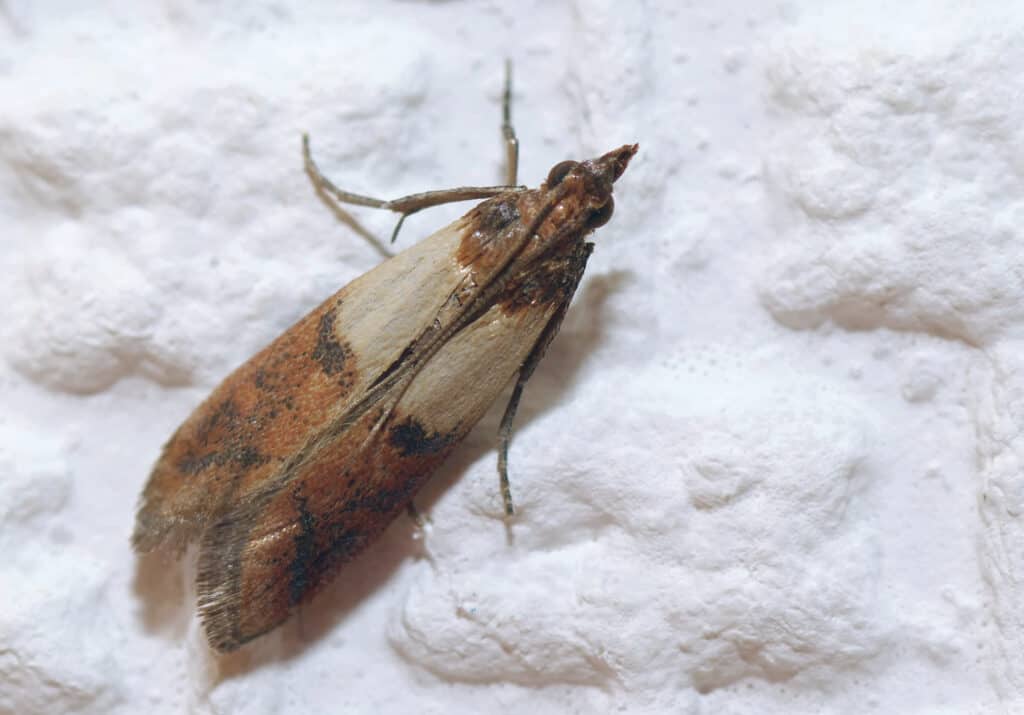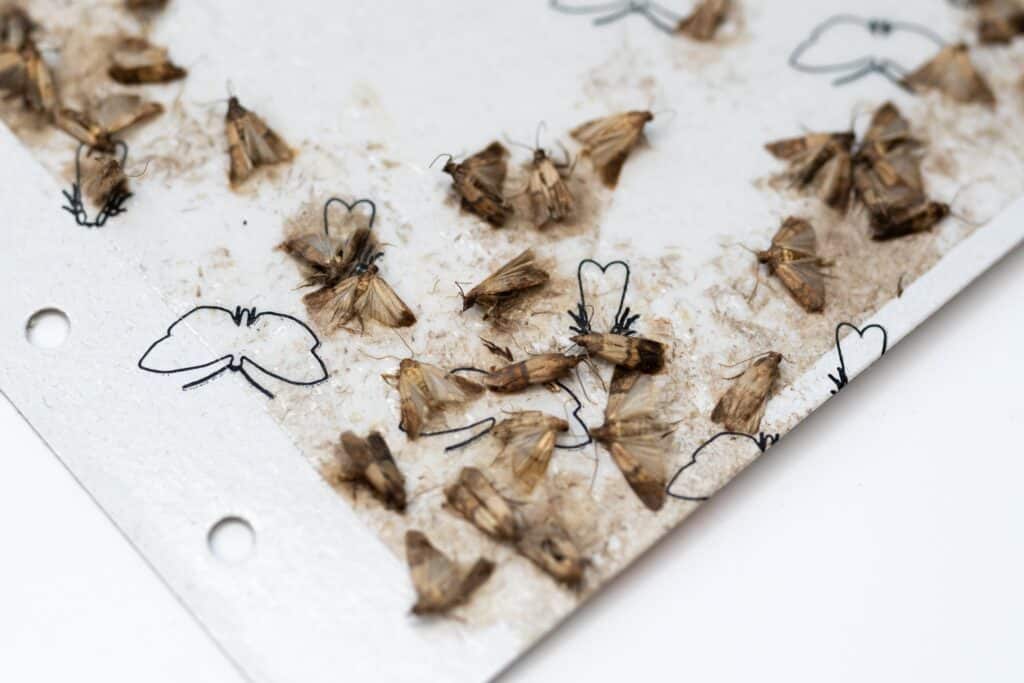Having a pest of any kind in your home can feel like an invasion, especially when they take over and infest your food. There’s nothing worse than stocking your pantry with dry goods, only to find larvae and pesky moths inside bags, boxes, and containers. You might think that well-sealed foods would prevent an infestation, but pantry moth larvae can chew their way through plastic and thin cardboard. Thankfully, there are ways to eradicate and prevent pantry moths in the home.
If you have a moth problem in your food storage, check out these seven effective ways to get rid of pantry moths once and for all.
What Are Pantry Moths? Where Do They Come From?

Indianmeal moths have primarily grey and brown wings.
©Bildagentur Zoonar GmbH/Shutterstock.com
The pantry moth, also known as the Indianmeal moth, is a small, winged insect with brown, gray, and tan coloring. These bugs are common in the United States, where they like to invade homes, grocery stores, and food processing plants. They can enter your home by doors, windows, and vents. But most infestations occur because the larvae were already inside the food before you brought it home. From there, caterpillars and adult moths can escape their original containers and infest other unsealed food. You may find pantry moths in all their forms, from eggs to caterpillars and adults.
What Problems Do Pantry Moths Cause?
Pantry moths are harmless to humans in the sense that they don’t bite, sting, produce toxins, or carry disease. However, the contamination of your food storage can be expensive and time-consuming. These moths will infest items in your pantry, such as bread, flour, pasta, grains, seasonings, cereal, and any processed snacks. And any infested food must be thrown out to prevent further contamination.
How to Get Rid of Pantry Moths for Good

Indianmeal moths commonly attack household food products.
©Tomasz Klejdysz/Shutterstock.com
1. Inspect and Throw Away Food
The best way to inspect the damage and extent of the infestation is to take all of the items out of your pantry and comb through every last bag, box, etc. Throw away anything that contains eggs, caterpillars, and moths. But put them into a separate trash bag from your regular trash bin to ensure they don’t find their way back.
While you should check all items, these are the most favored products of pantry moths:
- Cereals
- Grains
- Flours
- Dried fruits
- Beans
- Nuts
- Dry animal food
- Candies and chocolate
- Bread
- Pastas
- Seasonings
- Birdseed
- Processed snacks
After you’ve finished throwing away all contaminated items, take the tightly sealed bags outside and place them in bins away from walls and windows. You don’t want to encourage them to come back inside.
2. Clean, Clean, Clean
Throwing away infested food items is the first step. But pantry moths can also hide in cracks and crevices inside your empty pantry. Next, it’s time to clean.
The best way to get rid of any dead bugs, larvae, and crumbs is to thoroughly vacuum every inch of your pantry, including floors, shelves, undersides of shelves, cracks, door hinges, and crevices. Then use warm, soapy water and a rag or sponge to scrub down shelves and walls. It also wouldn’t be a bad idea to mop the floor with the same solution. Alternatively, you can clean with a water and vinegar solution, then wipe down with peppermint oil.
3. Check and Recheck Food Items, Then Freeze
Even items that you believe were unharmed could still be harboring eggs and larvae. Before you place items back into the pantry, re-check them for any signs of infestation. Even plastic bags that were tightly sealed could be affected, as larvae can chew their way through bags and thin cardboard. If you don’t see any damage, you can still place suspect items into the freezer at a temperature at or below zero degrees for three or four days. This freezing process can eliminate unseen eggs that may be present.

Use traps to get rid of pantry moths.
©CatwalkPhotos/Shutterstock.com
4. Get Glass or Metal Containers
Before you restock your pantry, wait several days to ensure the problem has been taken care of. Once you’re confident that all of the eggs, larvae, and moths are gone, place all pantry items into sealed glass or metal containers before bringing them back into the pantry. Moving forward, any items you bring from the store should be placed into these same air-tight containers. Even if you unknowingly bring pantry moths back into your home, these insects can’t chew their way through glass and metal.
5. Place Traps
If you still have reservations, you can place a moth pheromone trap inside your pantry to attract and catch any remaining pests. The pheromone traps will attract the insects all to one spot, making it easy for you to see the extent of how many are left and get rid of them.
6. Hang Sachets of Natural Herbs
Moths are repelled by certain scents, so it wouldn’t be a bad idea to make little sachets filled with bay leaves, peppermint, and cedar chips and hang them around your pantry. Plus, they smell nice, too!
7. Inspect Pantry Regularly
The best way to prevent another infestation from occurring is to regularly inspect your pantry and new food items. And you can also inspect the cleanliness of the shelves, boxes, and bags at the store. If you see spillage around food products or any holes in boxes, you should skip it and notify an employee.
The photo featured at the top of this post is © Tomasz Klejdysz/Shutterstock.com
Thank you for reading! Have some feedback for us? Contact the AZ Animals editorial team.







